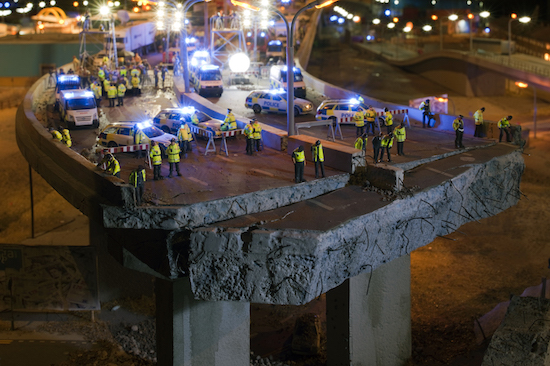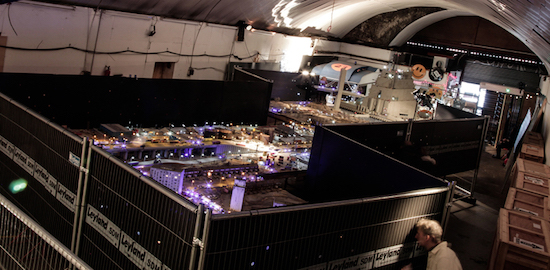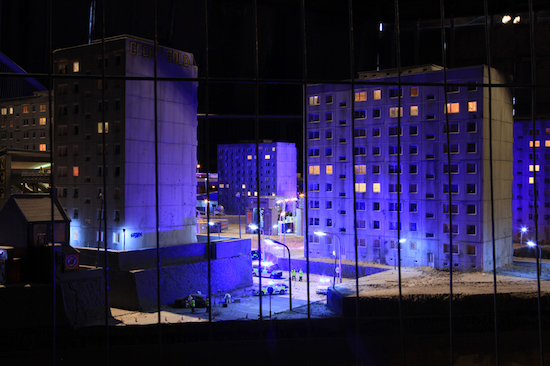The man who once burnt a million pounds with Bill Drummond has built a vast 448 square foot diorama of an apocalyptic, burnt out Bedfordshire town. Jimmy Cauty’s diminutive disaster area, the aftermath of some epic riot-to-end-all-riots now in heavy police lockdown, is modelled at a scale of 1:87, and populated by some 3,000 plastic riot cop figurines. This charred landscape of broken windows, flashing strobes, and collapsing buildings has spent most of the last few months on display under a railway arch in Southwark. But now The Aftermath Dislocation Principle is going on tour.
Stuffing the whole display into the back of a 45-foot shipping container, Cauty and his team will be taking it to the sites of historic riots, the length and breadth of the country. Maybe, along the way, they might just start a riot or two of their own.
“Quite often,” Cauty tells me over the phone, “if I drive past a McDonalds, I imagine a lorry crashing through it and it all just completely smashed to pieces. I don’t know why I want to depict that. I could try and make it out in the real world, but that’s just going to get me into trouble.” He tells me his model village represents a possible vision of England “in the very near future.” A few more years of Austerity, of rising prices and cutting services, maybe another big financial crash – then Boom! “It’s not hard to imagine it could get like that,” he says. “It wouldn’t take much for it to tip over. It would only take the electricity to go off for a couple of days and then the police are gonna be, right, this is our big chance, let’s get out there and run everything!”
The idea goes back to 2011 when Cauty started making tiny scale models of motorway pile-ups, burnt out and graffitied churches, policemen peering into a branch of Chicken Cottage. He housed them in upturned jam jars, a symbol, apparently, of “containment”, of “violent disturbances served up in manageable doses like news bulletins.” He called them A Riot in a Jam Jar. One day he got a call from Steve Lowe of the gallery L-13 Light Industrial Workshop.
“Steve said, look, do you want to do another Riot in a Jam Jar show? And I was like, mmm, not really, no. But I’ve got this other idea. He said, have you got any drawings? Nope. So he said, ok, well we’ll just start putting money into your bank account until it’s finished then. L-13 just pumped money into my bank account for nine months and at the end of it we emerged with this thing.”

Photo credit Thomas Mayer
The Aftermath Dislocation Principle was first show in Hoxton Arches back in 2013. After that it travelled round the Netherlands. Finally it came home and sat in storage for a bit. “We didn’t really know what to think,” Cauty admits. Somehow the show had failed to quite capture people’s imaginations. “Then Banksy got in touch.”
The anonymous graffiti artist wanted Cauty to make some of his signature smiley-faced riot shields to go in his Dismaland theme park in Weston-Super-Mare. “I said, have you seen this other thing I’ve got?,” Cauty recalls. “Because it really fits in well with your thing. It was quite a big hit down there. Since that point, suddenly it’s a massive hit.”
Upon leaving Dismaland, they packed the diorama up and took it to America Street where they also housed a workshop staffed by volunteers, busily building new additions alongside Cauty himself. “So that’s been quite weird,” he admits. “Normally I just work in a darkened basement. I never meet or see anybody. But this has been really out there, interacting with people while I’ve been doing it.”
“One of the things we tried here is to put a fence around it and drill holes through so you literally look through these tiny holes at it. We weren’t sure whether that was going to work, but people really liked it.”
It was the addition of the fences – with its little peepholes – that inspired the solution to what had been one of the more frustrating aspects of the show: “I had to rebuild it every time we moved it!” Cauty had long dreamed of putting it all in a shipping container so he could just leave it set up and never have to remake the blasted thing, but he couldn’t work out how to fit the people in, to walk around and see it. Peepholes solved that problem – and proved, rather like Marcel Duchamp’s late work, Étant Donnés, which is visible only through a pair of small holes in a wooden door, to have an allure all of their own. “It does draw you in that thing. Part of the thing is the sense that maybe you’re not supposed to be looking, so people are drawn by that.”

Photo credit Nadia Otshudi
So are you hoping to reclaim shipping containers from the pop-up malls and cupcake stalls? I ask.
“It would be nice, wouldn’t it?” he says, laughing. “But, no, it’s too late! They can’t be reclaimed! It’s all over for shipping containers.” The bottom line is, they needed some way of moving a very large model around, and “a shipping containers is something that is built to be moved around.”
“What I did is I got a map of the British Isles and just with a big Helvetica font, wrote RIOT from the south to the north in a very thick, wide font,” Cauty tells me. “So if your town fits within the text then we’ll bring it there. We’re asking people to help host it. If they’ve got an idea for a place we can go, then get in touch with us. We’re saying you can go back a thousand years and the riot can be within a 20 mile radius of your location.”
“We wanted to take it to the Beanfield [site of an infamous ‘Battle’ between the Wiltshire Police and a Peace Convoy on route to Stone Henge, in 1985], but there’s actually a dual carriageway going right through that. So we might just have to be in a lay-by near there. I think that’s probably good enough.”

Photo credit Irati Gorostidi
William S. Burroughs once theorised that if you were to record the sound of a riot on a tape recorder and play that sound back on any normal, busy street, then the sound would be enough to incite ordinary peaceable shoppers to start rioting themselves. Are you, I ask Cauty, hoping to provoke people into kicking off when you turn up in their town with your Aftermath Dislocation Principle?
“Well,” he chuckles, “I mean, yeah… Because one of the things I’m saying is, yes, sites of historic riots, but it could also be sites of possible future riots as well. That’s on the agenda.”
“I did have a police day last week where I invited the Met down [to America Street] just to have a look. I wanted to get some photographs of them looking through the holes. I was saying to one of them, could you not just, for publicity, arrest me for inciting a riot? But I mean they loved it. They just thought it was hilarious. I don’t know what to think about that.”
I suppose, with all the hazard tape and flashing lights, a city deserted except for several thousand cops, it does represent a kind of police utopia, I suggest.
“It is that. There’s nothing really for them to dislike. They’ve taken over absolutely everything. They’re running the whole show. It is the world they want to create. The only thing negative for them is they all look really bored and they’ve got nothing to do. But that’s the price you pay, I think, for getting everything you want, getting it all your own way.”
The Aftermath Dislocation Principle Uk Riot Tour is coming soon, for more information check out the L-13 Website


